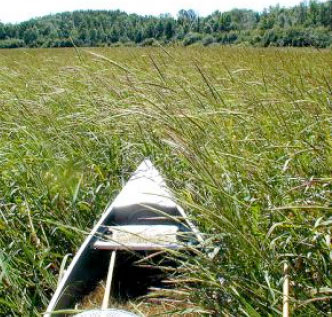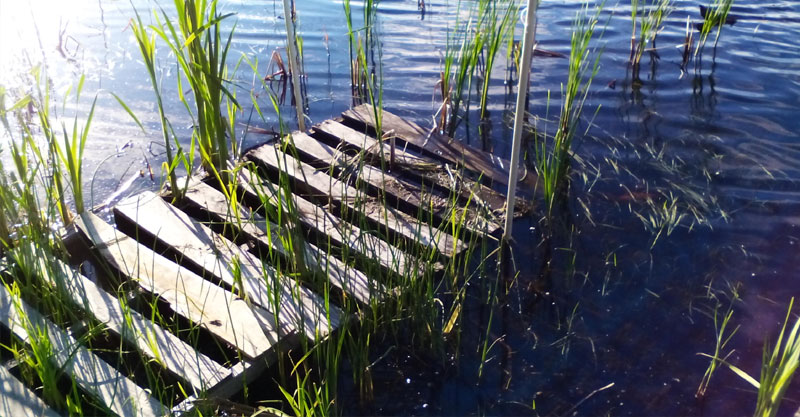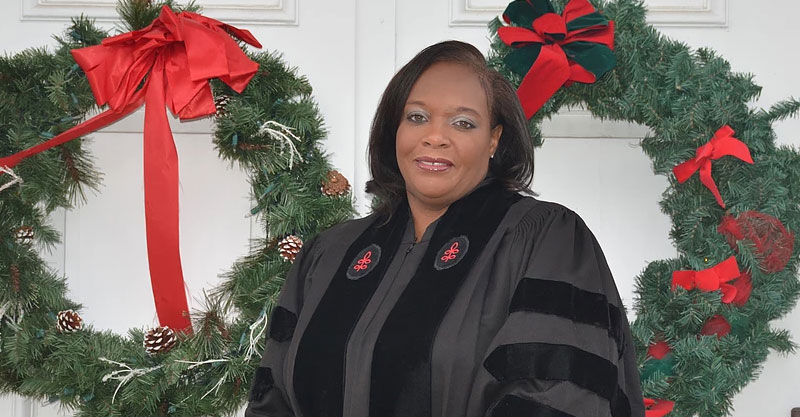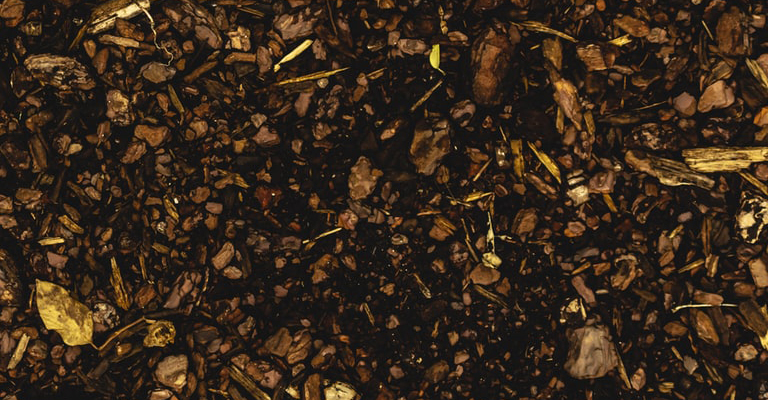from Marquette Monthly December, 2004
The plight of replanting wild rice in the Upper Peninsula
I remember it clearly. My heart jumped. I was dozing off during an environmental conference, sponsored by the Lake Superior Binational Forum, on the Bad River Reservation ten miles east of Ashland. Down the hall you could hear the low jingle from the casino.
We were listening to presentations on environmental restoration efforts in the Lake Superior Basin. A particular series of aerial photographs struck me. I will never forget them. A soft-spoken tribal representative was reviewing their wild rice (Manoomin in the Ojibwe language) seeding project. He framed his presentation with a projection of 35mm slides showing contrasting seasonal photographs of large, expansive wetlands.
“Here are examples of different harvests of wild rice over the last five years,” he said. “Planting of wild rice remains a mystery, even to us. Some years, our wetlands are filled with rice as far as the eye can see. Other seasons, there’s virtually nothing. Manoomin is not like other plants and crops. A lot depends on fluctuating lake and stream levels, the temperature of the water, the winter snowfall. Thousands of intricate variables, all connected to the earth, contribute to the fragile viability of wild rice harvests here in Northern Wisconsin. It’s hard to predict. Sometimes we’re all surprised.”
Then the presenter lowered his voice and spoke with a measured reverence describing the cultural heritage, his Anishinaabe tradition, that, for hundreds of years, has served to bind ritual, wild rice and tribal customs together. We learned that Aizania palustri, what botanists call wild rice, is a diminishing species, largely due to unregulated lakeside developments and expanding efforts to control natural fluctuations of water levels. He reminded his listeners that very few habitats in the world still meet the specific conditions necessary to harvest wild rice. Some of these locations are found here in Michigan’s Upper Peninsula.
We discovered Manoomin, once a treasured source of nourishment and sacred meaning for the Ojibwe, is facing dramatic decline due to impacts of erosion, dams, use of motorized boats and unregulated point-source pollution. Most of us were surprised, many dismayed, to discover ninety-five percent of all wild rice is now grown commercially in rice paddies in Northern California.
This gourmet food, sold for high prices in elite gift shops, has become another expression of global agribusiness. It’s often packaged, to the ongoing chagrin of our Upper Midwest Native neighbors, with American Indian insignia and logos to enhance its “natural” Indian-affiliated, romantic appeal.
That was two Septembers ago. In the months that followed, after extensive conversations with Native American leaders in Marquette County, Sault Ste. Marie and Baraga, an idea was born. Thanks to encouragement from Marty Reinhardt, Jesse Luttington and the Cedar Tree Institute, a wild rice planting initiative was launched with a start-up grant from the Emerick Family Fund of the Marquette Community Foundation. Reinhardt is NMU’s Department of Native American Studies director and member of the Sault Ste. Marie Band of Chippewa Indians; Luttington is an economic development officer for the Keweenaw Bay Indian Community.
This summer I spent several weeks immersing myself in a rice planting project with tribal members, a dozen teenagers from Marquette County’s Juvenile Court Diversion program, three NMU students and a handful of local volunteers. Carl Lindquist and support staff from the Central Lake Superior Watershed joined us with waders, maps, canoes and GPSs (global positioning systems) to map and identify five prospective planting sites in Marquette County.
It has been more than one hundred years since wild rice may have been harvested in any of those sites. In June, the slow, healing work of bringing Manoomin back into the Marquette County landscape began, carefully and respectfully. Cedar Tree Institute friends from the Jewish community reminded me that this kind of effort is a part of a quiet spiritual movement called Tikkun Olam, a Hebrew term for “repairing the earth.”
The spirit of the Peoples of the Three Fires, who first lived on this land—the Ojibwe, Potawatami and Ottawa—guided each step of the way. The Keweenaw Bay Indian Community, along with Marquette County’s American Indian Coordinating Council, served as key partners.
The KBIC tribal council blessed us with a gift of 400 pounds of wild rice seed, hauled over in the back of a van from a reservation near Minnesota’s boundary waters, 300 miles away.
One Saturday afternoon in July, seven tribal elders traveled from Baraga and L’Anse for a blessing of the rice at Marquette’s Presque Isle Park, not far from Chief Kawbawgam’s grave site. Sounds of jazz and drums drifted over the trees on the ridge behind the pavilion. A bedraggled but enthusiastic gathering of tennis-shoed teenagers, court probation officers, retired folk, social workers, musicians and blue-jeaned clergy feasted on wild rice concoctions, barbecued chicken and assorted dishes offered by a wide variety of project supporters.
Those weeks were an introduction into a hidden world. Winona LaDuke and Brian Carlson, Ojibwe leaders from Minnesota’s White Earth Reservation, tell us that radiocarbon dating of wild rice pollen indicates that most of Minnesota’s wild rice (as Michigan’s) predates by at least 1,000 years the Native American peoples who first used it.
The Anishinaabe say, from the beginning, it was a sacred food. Legend has it their ancestors were told by the Creator in a dream that “food growing on the water” would await them in this part of the world as they migrated east hundreds of years ago. Wild rice would sustain and hold their communities together with prayers and celebrations. Today, common names for rivers, townships and villages in Northern Michigan come from the Ojibwe word Manoomin (wild rice) and Ininii (people). (Translated from the Ojibwe language Menominee means “people of the wild rice.”)
One early afternoon in August, twelve of us sat perched on a dramatic granite outcropping overlooking Harlow Lake, just off CR-550. KBIC tribal member Don Chosa and his two children, Leon and Dalene, came to help us identify prospective seeding sites, rivers and wetlands that might provide the best chance for wild rice to grow. It was an extraordinary day—bright and brisk, with clear skies. Following a lunch of peanut butter sandwiches, dried fruit and bottled water, we read aloud to each other a short essay by Minnesota’s Sigurd Olsen, one of the most beloved, revered conservationists of the twentieth century.
Olsen noted that Father Marquette, on his expedition with Joliet in 1673, was among the first to describe wild rice. He spoke of “tall grass growing in small rivers and swampy places.” He noted in his journal how Native American peoples would gather and prepare this food in the month of September. This Black Robe, as Jesuits were called by Indians, took detailed notes of how The People of the Three Fires gathered ears of rice from hollow stems into canoes, dried them over a slow fire and later danced upon the grain to separate husk and chaff.
The French explorer Radisson, during his own travels into the Michigan-Wisconsin area in 1660, left this account: “Our songs being finished, we began our teeth to work. We had a rice much like oats. It grows in the water three or four feet deep. Native peoples have a particular way to gather up that grain. Two take a canoe and two sticks by which they get the ear down, and get the grain out of it. Their boat being full, they bring the grain to a fit place and dry it. This is their food for the most past of a winter. Each gets a handful that they put in a pot. It swells so much that it can suffice a man.”
There are older traditions. Long before the Jesuits and French traveled into these regions, the Ojibwe, Potawatomi and Ottawa would gather around winter fires to retell their own stories of the origin of wild rice. Among them is the tale of Nanaboozhoo, the cultural hero of the Anishinaabe who was introduced to wild rice by a duck.
One evening Nanaboozhoo returned from hunting but he had no game. As he came toward his fire, there was a duck sitting on the edge of his kettle of boiling water. After the duck flew away, Nanaboozhoo looked into the kettle and found wild rice floating on the water, but he did not know what it was. He ate his supper from the kettle, and it was the best soup he had ever tasted. Later, Nanaboozhoo followed the direction which the duck had taken and came to a lake full of Manoomin. He saw all kinds of ducks and geese and mud hens, and all other water birds eating the grain. After that, when Nanaboozhoo did not kill a deer, he knew where to find food.
Unfortunately, wild rice often is not considered of value apart from its function as a culinary delight. This is a critical mistake. Manoomin in many ways, naturalists remind us, is a “signal species,” an indicator of the conditions and interplay of a complex, fragile ecosystem. It plays specific roles in the vital biodiversity of Michigan’s wetlands, providing habitat for ducks and other wildlife. With its roots, it serves as a natural form of erosion control and cleanses the water of streams and shallow lakes by absorbing nutriments and algae.
Lac View Desert, a picturesque lake which borders Wisconsin and Northern Michigan, once was known as a premier duck refuge and hunting site. In 1937, a hydroelectric dam was built. Wild rice and the ducks began to disappear. Manoomin needs shallow, moving water, clear of pesticides and toxic waste. It needs the subtle fluctuation and shifts of water levels that characterize the dramatic changing seasons.
Domestication of wild rice began in the 1950s and triggered the decline of natural harvesting. Major corporations such as Uncle Ben’s began production. Universities were contracted to provide information to improve production, to make rice harvesting more efficient. Advertising flooded the market to make the public aware of the mass availability of this new product.
This focus on increased efficiency in planting and harvesting caused a cascade of unforeseen environmental problems. Wetlands were drained, lakes were dammed. Herbicides and pesticides soon destroyed the delicate water conditions needed for future wild rice production in many lakes in Michigan, Wisconsin and Minnesota. Within twenty years, much of the crop was relocated from its home in the Upper Midwest to Northern California.
Wild rice requires flowing water. It grows in depths of a half of a foot to three feet, with a one-to-two-foot depth being optimal. Wild rice thrives in several inches of soft, organic muck, but will tolerate other soils and bottom conditions, sometimes including sand and gravel. The seed remains viable in the sediment for five years or more.
The most common problems affecting rice stands are changes in water levels, or turbidity (suspended sediment in the water). High turbidity prevents light from reaching the plants. Boat wakes contribute to the decline of wild rice. Seeded areas are subject to high wave action from boats and personal watercraft. The rice plants often fail in the floating leaf stage (late spring and early summer) when the plants are very vulnerable.
Spiritual and cultural values related to wild rice and its harvesting are dismissed by those carrying a more singular interest in the natural environment. In Manoomin Our Life, the Annishanabe Struggle to Protect Wild Rice (2003), LaDuke and Carlson cite a report to the Minnesota Legislature in the 1950s, commissioned by the Legislative Commission on Minnesota Resources. Researchers characterized the relationship of Native American people to rice as a “September Santa Claus” and a “Good berry Mardi-gras.”
The report mentions that traditional rice harvests provided tribal communities an annual “time for a spending spree.” As Ojibwe traditionalists struggle to regain and protect what is left of their culture and spirituality, they face an onslaught of competing values, not focused on family and community, but on commercial development and profit margins.
On a shelf above the fireplace at our home sits a small, sealed glass container of wild rice harvested by Cree and Ojibwe peoples who live near the shores of Lake Superior.
During the planting in September, a tribal representative scattered a handful of tobacco, in ritual of thanksgiving, over the waters of a small remote inland lake. As our team of teenage and elementary youth began to throw wild rice seed by hand along the marshy shoreline, I realized that, in a month or two, ice would cover the streams and wetlands.
Turning to our guide from one of the area tribes, I inquired, “How will it establish a place to grow in the water?” He smiled and with a nod of the head replied, “The seeds attach themselves to the river beds and mud of wetlands. Ice actually helps the process. It digs, then pushes seed into the bottom of the marsh. It takes three to four months of below-freezing weather, before rice seed will germinate.”
I’ve thought often about his description of this mystery. During dark December days, as the earth sleeps under a frozen, iron blanket of ice and snow, the seeds of Manoomin work their way into frozen mud and marsh.
As we hunker down in the shelter of our homes during coming winter storms, dormant seeds of wild rice lie hidden deep within frozen lakes and wetlands. Fought for, defended by Peoples of the Three Fires.
In a coming spring, it may bring its gift to us. But for now it rests and waits, still a promise, prayed for in ancient languages of this land, preparing to be born.
– Jon Magnuson
December 2004




